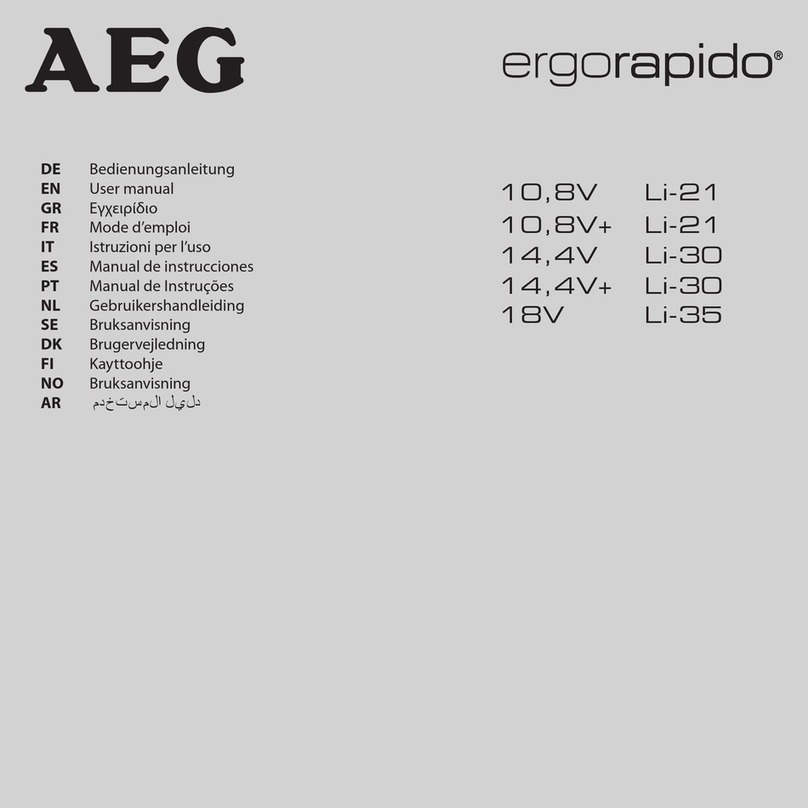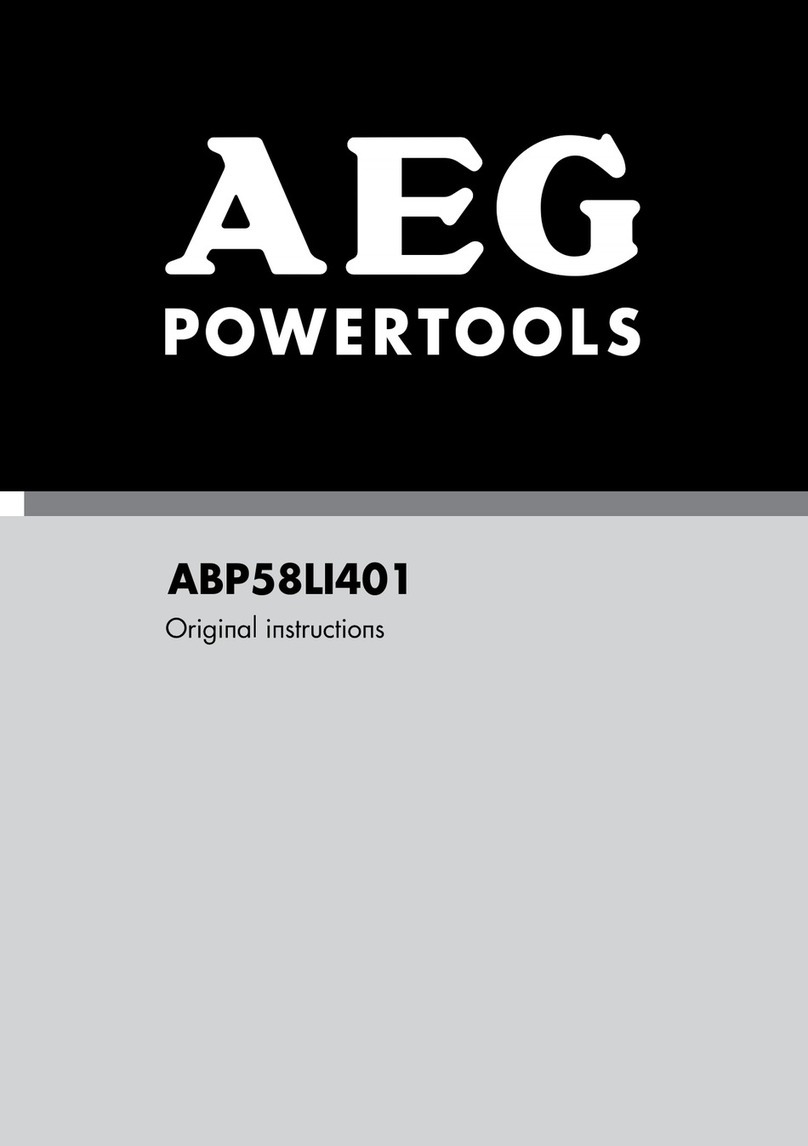
4
4
■If four LEDs turn yellow, the battery pack is fully charged. The battery
pack capacity is between 85%-100%.
■If three LEDs turn yellow and one is off, the battery pack capacity is
between 60%-85%.
■If two LEDs turn yellow and the other two are off, the battery pack
capacity is between 35%-60%.
■If only one LED turns yellow and others are off, the battery pack
capacity is lower than 35%. In this case, the battery pack can be used
as usual until automatically turned off by the control program.
■If only one LED flashes yellow and others are off, the battery pack
capacity is less than 10%. The under-voltage protection is activated.
BATTERY PROTECTION
See page 7.
AEG 58V lithium-ion batteries are designed with features that protect the
lithium-ion cells and maximise battery life. If the tool stops during use, the
following may be the causes:
■Over-current protection is active. The maximum draw of the battery
pack has been exceeded, causing it to automatically stop powering
the product.
■Over-temperature protection is active. Excessive temperatures caused
the battery pack to stop powering the product.
If the tool still does not work, the battery may not be sufficiently charged.
Recharge the battery.
To determine if a battery protection feature is active, press the charge level
indicator button:
■If the second and third LEDs are flashing, the over-current protection
is active. Remove the battery pack to reduce the current.
■If the first and last LEDs are flashing, the over-temperature protection
is active. Remove the battery pack and allow it to cool down.
CHARGING THE BATTERY PACK
Battery packs are shipped in a low charge condition. Charge them until the
green LED on the front of the charger turns on.
If the charger does not charge the battery pack under normal
circumstances, contact an authorised service centre for related advice.
Remove the battery pack when charging is complete.
TO CHARGE
■Use a battery pack only with the recommended charger.
■Connect the charger to the power supply. Make sure that the power
supply is the normal household voltage, 220-240 V AC only, 50 Hz.
■Make sure that the latch of the battery pack clicks into place and the
battery pack is secured in the charger before beginning operation.
■Slide the battery pack along the groove of the charger.
■Press down on the battery pack to ensure that the contacts on the
battery pack engage properly with contacts in the charger.
■Do not place the charger and battery pack in an area of extreme heat
or cold. They work best at normal room temperature.
NOTE: The charger and battery pack should be placed in a location where
the temperature is more than 10°C but less than 38°C.
■The battery pack becomes slightly warm to the touch while charging.
This is normal and does not indicate a problem.
■After charging is complete, the charger green LED remains on until
either the battery pack has been removed from the charger or the
charger has been removed from the power supply.
■After charging is complete, the battery pack LED indicator remains on
for 1 min then turns off. But if the battery pack has been removed from
the power supply, the battery pack LED indicator turns off.
■When batteries become fully charged, unplug the charger from the
power supply and remove the battery pack.
■Press the latch of the battery pack to remove the battery pack from
the charger.
CHARGING A HOT BATTERY PACK
If the battery pack is above the normal temperature range, the charger
red LED flashes and the green LED turns off. When the battery pack cools
down to approximately 45°C, the charger automatically begins fast charge
mode.
CHARGING A COOL BATTERY PACK
If the battery pack temperature is below 3°C, the charger red LED flashes
and the green LED turns off. When the battery warms to a temperature of
more than 5°C, the charger automatically begins charge mode.
COLD WEATHER OPERATION
The lithium-ion battery pack can be used in temperatures down to -20°C.
Put the battery pack on a tool and use the tool in a light duty application.
After about a minute, the pack will have warmed up and begin operating
normally.
MAINTENANCE AND STORAGE
AEG battery packs have been designed to provide maximum trouble-
free life. However, like all batteries, they will eventually wear out. Do not
disassemble the battery pack and attempt to replace the battery cells.
Handling of these batteries, especially when wearing rings and jewelry,
could result in a serious burn.
To obtain the longest possible battery life, follow these storage instructions:
■Remove the battery pack from the charger once it is fully charged
and ready for use.
■For battery pack storage longer than 30 days:
• Store the battery pack where the temperature is below 38°C and
away from moisture.
• Store battery packs in a 30%-50% charged condition.
• Every six months of storage, run the battery with a tool until cut
off by pack’s program control. Then charge the pack as normal.
charge the battery pack as normal.
BATTERY PACK REMOVAL AND PREPARATION FOR RECYCLING
To preserve natural resources, please recycle or dispose of batteries
properly.
This product contains lithium-ion batteries. Local regulations may prohibit
disposal of lithium-ion batteries in ordinary trash.
Consult your local waste authority for information regarding available
recycling or disposal options.
WARNING! Upon removal, cover the battery pack’s terminals with
heavy-duty adhesive tape. Do not attempt to destroy or disassemble
battery pack or remove any of its components. Lithium-ion batteries must
be recycled or disposed of properly. Never touch both terminals with metal
objects or body parts as short circuit may result. Keep battery packs away
from children. Failure to comply with these warnings could result in fire
and/or serious injury.
SYMBOLS
Read the instructions carefully before using the
product.
Regulatory Compliance Mark (RCM). The product
meets applicable regulatory requirements.
Waste electrical products should not be disposed
of with household waste. Please recycle where
facilities exist. Check with your local authority or
retailer for recycling advice.
Recycle lithium-ion batteries





























